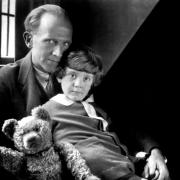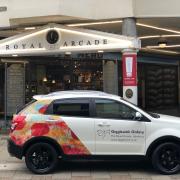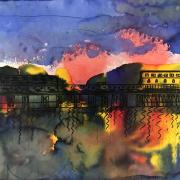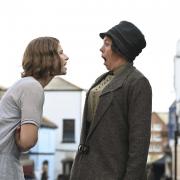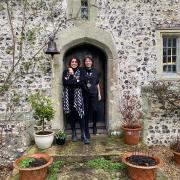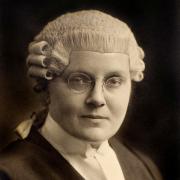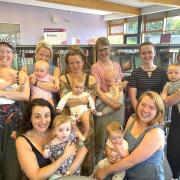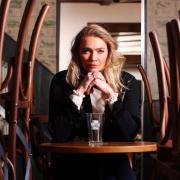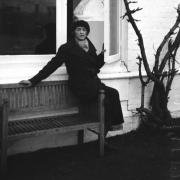The first reprint in nearly 80 years of The Sussex Alphabet by Eleanor Farjeon has revived interest in a writer who left an indelible mark on the Downs. Sue Scott investigates
The Sussex Downs are indelibly associated with literary figures, their domestic and professional histories signposted by blue plaques and brown tourist trails, but none has left their footprint on the landscape quite so literally as Eleanor Farjeon – nor perhaps has been commemorated less.
Best known as the author of the hymn Morning Has Broken, this extraordinary product of a Victorian nursery – whose governess was told not to teach the children anything they didn’t want to learn – was by turns an accomplished poet, composer, biographer, satirist, author and columnist, whose wry observations of adults and instinctive ability to communicate with children led to 80 books, 20 musical works and many more published pieces.
Her creative success – for she was widely read in her lifetime and left a legacy for which some of today’s Eleanor Farjeon Award-winning children’s authors can still be grateful – was largely due to the Downs. They healed her, inspired her and populated her prose and poetry with marvellous characters that stepped straight from the byways she “stomped”, day and night – frequently alone, but sometimes joined by friends. Most notable among these were the inveterate rambler Edward Thomas, who encouraged her adventures as fervently as she encouraged his poetry and whose death 100 years ago at the Western Front on Easter Monday 1917 deeply affected her personal and literary future.
The war might have robbed the 20th century of a distinctive and important voice, but the trauma of losing the man Eleanor acknowledged as her first love would result in a deeper affection for Sussex than might otherwise have been the case. And it’s that affection being celebrated with a unique living literature project that will see two of her most popular anthologies brought back into print this month for the first time in decades.
Eleanor left in volume and diversity as great a mark on the English literary landscape as that of her friend. Not least was a huge canon of work claimed by children all over the world, which inspired, enthralled and led their imaginations down Lewis Carroll-shaped rabbit holes of reading that were just as eagerly explored by adults. Among her fans was the Queen Mother, who had Eleanor’s delightfully irreverent but instructive set of poems, Kings & Queens, tracing the history of all 41 of them since William I, in the Royal nursery!
Born into a family of writers, actors and musicians, and into a household where she had free range of 8,000 books, Eleanor’s own literary career was a slow burn. “I grew up dreamily in a world of illusion that continued unbrokenly and dangerously until I was nearly 30,” she wrote.
Her first collection of poems was published in 1908 when she was 28, four years before she met Edward, who initially resisted her suggestion that he, too, should write verse. She went on to become one of his most trusted poetic critics, but it wasn’t until Edward’s death that she really began clearing her own creative path. It led irresistibly through the leafy Sussex byways and over the windlashed slopes that Edward had introduced her to on their rambles.
Not long after hearing of his death, Eleanor rented an old, thatched farm cottage with cows and children running past her door in the hamlet of Houghton, West Sussex. Here, she would spend two years, getting over her grief and learning – as her biographer and niece Annabel Farjeon put it – not to be afraid: “As a child, she had feared almost everything… now she taught herself to be alone. She walked the Downs at all hours of the day and night… here she wrote and went to bed, leaving doors and windows open. It seemed to her an almost perfect way of living, filled with natural and necessary things, like collecting wood, picking flowers and mushrooms from the fields, watching the seasons change.”
Eleanor would herself describe how deeply affecting that landscape had been in a letter to English teacher George Earle with whom she set up home in East Sussex some time later: “They [the Downs] are so much beyond human beings to me that I almost cannot talk of it… I am theirs and if ever I vanish from the face of the earth, it will be because they have drawn me in… They’ve healed me more and given me more strength and certainty and peace than any other living thing.”
It was while she was living in the heart of ‘Eleanor Farjeon country’ – the sweep from Adversane, over the wild brooks and up the steep chalk scarp to Amberley Mount – that she wrote two of her best-loved stories: the first Martin Pippin novel set in an orchard in Adversane, which began as a clever allegory for adults, but quickly found favour in the nursery; and Elsie Piddock Skips in Her Sleep, which was based on a real little Elsie, who regularly kicked up her heels down what was known locally as Cow S**t (then Mucky, now South) Lane in Houghton. As with many of her other stories, both are peppered with just enough real-life references to make the impossibly true tales of magic spun by Eleanor’s colourful collection of characters almost credible.
So it was that Kithurst, Alfriston, Rackham Hill, and dozens of other villages and landmarks nestled in and close to the Downs became as familiar to children and adults around the world as they were to the Sussex folk who lived there.
And yet, despite winning three notable awards for children’s literature – the Carnegie Medal of the Library Association, the Hans Christian Andersen Award and the Regina Medal – and being nominated for an OBE (which she declined), Eleanor, who died in 1965, is hardly known among readers today, especially young ones. Two of her best anthologies – A Sussex Alphabet and All The Way To Alfriston – fell out of print.
But not for long. An extraordinarily ambitious project has seen hundreds of Sussex schoolchildren inspired by the ‘rambler poet’, who left her literary footprints all over the Downs, to create an entirely new set of verses. The collection will be published alongside the original Sussex Alphabet – the first time it’s been issued since 1939 when just 220 now highly sought-after copies were produced on handmade paper by Eleanor’s good friend James Guthrie’s Pear Tree Press in Flansham.
The idea for the new alphabet was conceived some 10 years ago by local historian and writer Dr June Goodfield and her friend and fellow historian Peter Robinson to celebrate the country’s newest National Park.
“We wanted to use Eleanor’s magnificent literary heritage to inspire everyone to identify those special features of the National Park that attracted them and then write their own poems for A South Downs Alphabet,” says June, who first came across Eleanor’s poems 20 years ago.
A partnership was formed between The Write House – an independent group of Sussex historians and writers founded by June and Peter and the South Downs National Park Authority to deliver the project, supported by schools and members of the U3A.
The 26 new poems reflect today’s Downs and their communities, just as Eleanor’s did when they first appeared as a series in the West Sussex Gazette – and were later collectively put to music by her brother Harry (the musical member of a prodigiously talented family). Each verse represents one letter of the alphabet, which in turn is related to the South Downs (albeit sometimes tenuously in Eleanor’s version).
The two parallel collections, separated by 100 years but joined by a common landscape, will be released this month by Sussex Snake River Press as part of a box set, which will also include the poem All The Way To Alfriston. One of Eleanor’s most evocative, it recalls a 50-mile walk from Chichester in 1915, part of which was reprised last year by June for Radio 4’s Ramblings with Clare Balding.
June has no doubt that Eleanor was a “great literary figure” deserving wider recognition.
“I think the marvellous thing about her is the way her work can go from the pragmatic and everyday to the utterly poignant and deeply moving, as in her poem Easter Monday about Thomas’s death. I’d love to have met her, gone on a walk across the Downs with her. I’m sure I would have liked Eleanor; the question is whether she would like me!”
Eleanor’s Sussex poems were often composed on the hoof, frequently in the company of Edward or others in their literary circle – a kind of West Sussex antidote to the Bloomsbury group. Among them was DH Lawrence, for whom she helped type The Rainbow. Lawrence was a willing companion but tardy walker, who explored slowly while Eleanor forged on purposefully in stout boots with a common stick and sometimes a clay pipe, criss-crossing the Downs and plains.
“I’d like to know what she had found changed in 93 years,” says June. “She would see very many more walkers on her ‘deserted’ Downs, people with mountain bikes and car owners exercising their own dogs; fewer sheep, but cows now, too. She would still hear the rain and the thunder but now she would also see contrails in the sky and the sound of jets approaching Gatwick.
“I would ask her what she perceives to be the essential elements of the Downs. Even though the sea is pressing on one side and the population on the other and the National Park receives 54 million visitors every year, what are the permanent elements of Sussex that will be here long after even we are gone?”
A Sussex Alphabet is published by Snake River Press. Available for £8.99 or as a box set with A South Downs Alphabet for £11.99.




